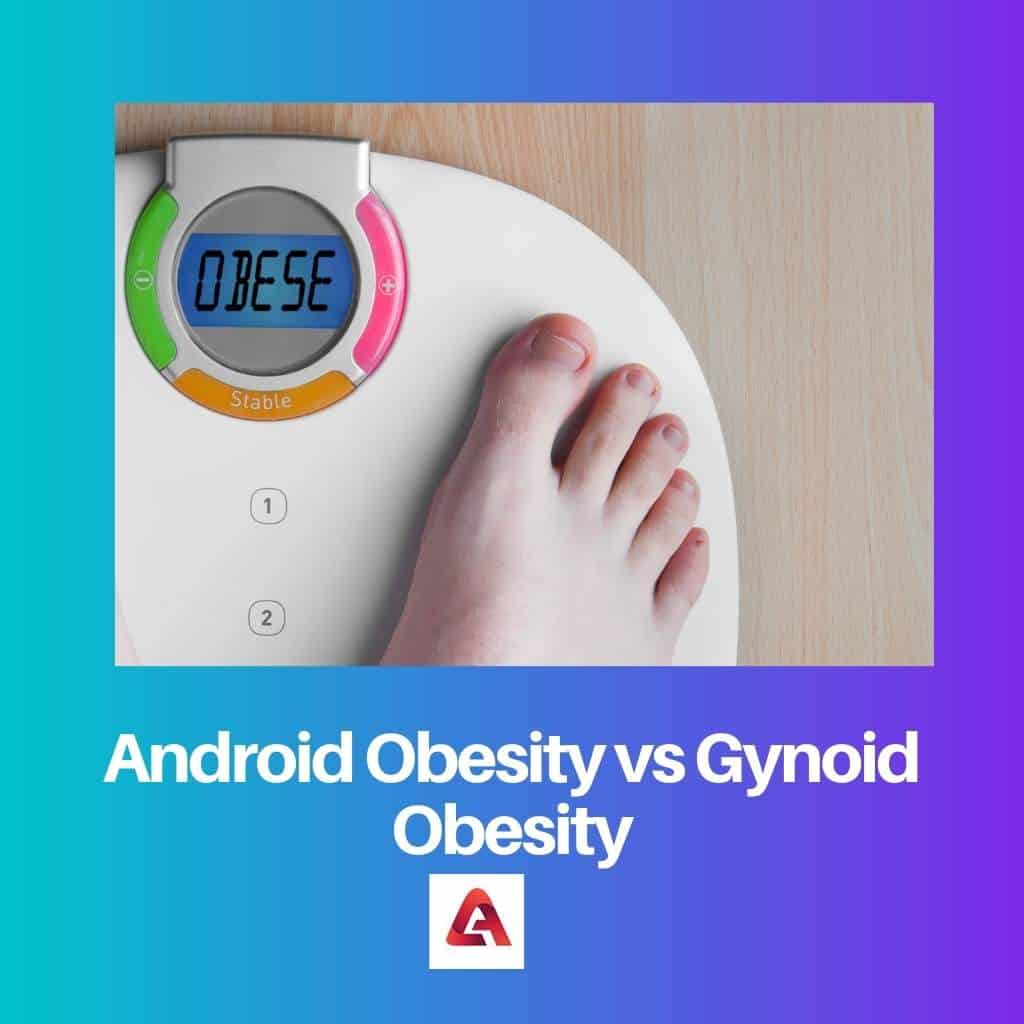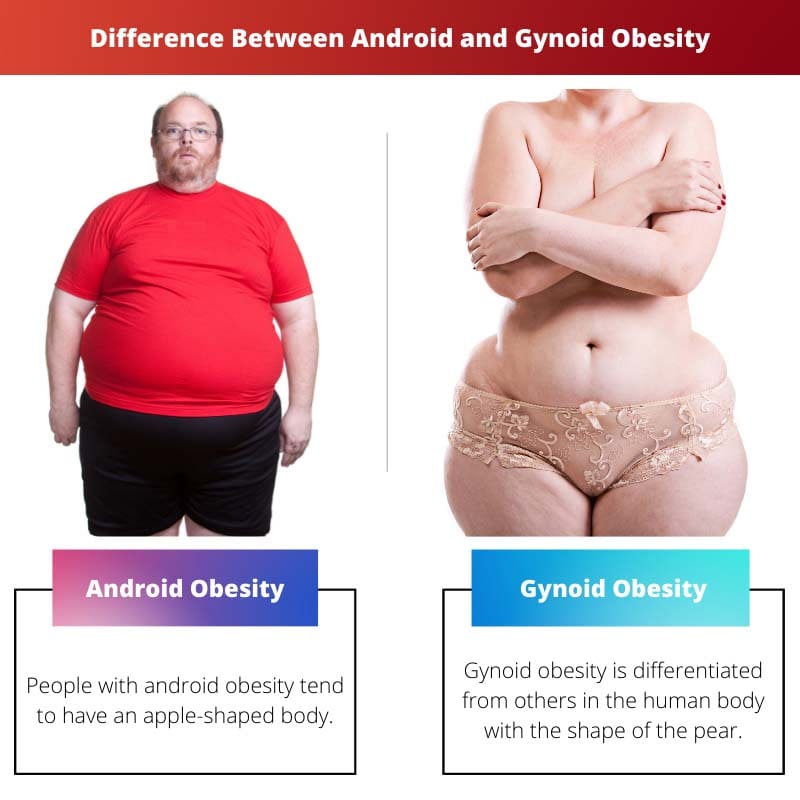Android obesity is characterized by excess fat accumulation in the abdominal region, leading to an “apple-shaped” body. This pattern is more common in men and is associated with a higher risk of cardiovascular diseases. Gynoid obesity, on the other hand, involves fat accumulation around the hips and thighs, creating a “pear-shaped” body, more prevalent in women and generally considered less risky for cardiovascular health.
Key Takeaways
- Android obesity is characterized by fat accumulation around the midsection, waist, and upper body, resulting in an “apple” body shape.
- Gynoid obesity is characterized by fat accumulation around the hips, thighs, and buttocks, resulting in a “pear” body shape.
- Android obesity is associated with a higher risk of metabolic disorders such as diabetes and cardiovascular diseases, while gynoid obesity is considered less harmful to health.
Android Obesity vs Gynoid Obesity
Android obesity, also known as central obesity or apple-shaped obesity, refers to the accumulation of fat around the abdominal area and upper body. Gynoid obesity, also known as peripheral obesity or pear-shaped obesity, refers to the accumulation of fat around the hips, thighs, and buttocks.

Android Obesity is seen at the centre of the body, basically the stomach. Their pattern follows an image of an Apple. On the other hand, they are prominently seen in men more than that in women.
Gynoid Obesity is also known as reproductive fat, as it aids with the pregnancy process. It is seldom seen on the breasts’ surface but frequently in the thighs, hips, and other lower parts.
Comparison Table
| Feature | Android Obesity | Gynoid Obesity |
|---|---|---|
| Fat Distribution | Upper body (abdomen, chest, shoulders, neck) | Lower body (hips, thighs, buttocks) |
| Nickname | Apple Shape | Pear Shape |
| More Common In | Men | Women |
| Cause | Primarily genetic and hormonal imbalances | Estrogen and predisposition for fat storage |
| Health Risks | Increased risk of heart disease, diabetes, sleep apnea, some cancers | Increased risk of joint problems (hips, knees) |
| Fat Type | Central (visceral) fat, more metabolically active | Peripheral fat, less metabolically active |
What is Android Obesity?
Android obesity, also known as central obesity or abdominal obesity, refers to the accumulation of excess fat around the abdominal region, particularly in the android or central part of the body. This type of obesity is characterized by an apple-shaped body where fat is predominantly stored in the abdominal area, as opposed to gynoid obesity, which is characterized by a pear-shaped body with fat accumulation in the hip and thigh region.
Causes
1. Genetic Factors
Genetic predisposition plays a significant role in android obesity. Individuals with a family history of central obesity may be more prone to developing excess fat around the abdomen.
2. Lifestyle Choices
Unhealthy lifestyle choices such as a sedentary lifestyle, poor dietary habits, and lack of physical activity contribute to the development of android obesity. Consuming a diet high in refined sugars and saturated fats can lead to fat accumulation in the abdominal region.
3. Hormonal Factors
Hormonal imbalances, such as elevated cortisol levels (stress hormone) and insulin resistance, can contribute to the storage of fat in the abdominal area. These hormonal factors are often associated with android obesity.
Health Implications
1. Cardiovascular Risks
Android obesity is linked to an increased risk of cardiovascular diseases. The excess fat around the abdomen can lead to higher levels of triglycerides and LDL cholesterol, contributing to atherosclerosis and hypertension.
2. Insulin Resistance and Diabetes
The accumulation of abdominal fat is associated with insulin resistance, a condition where the body’s cells do not respond effectively to insulin. This can lead to the development of type 2 diabetes over time.
3. Metabolic Syndrome
Android obesity is often a component of metabolic syndrome, a cluster of conditions that includes high blood pressure, elevated blood sugar, abnormal lipid levels, and increased abdominal fat. Metabolic syndrome increases the risk of cardiovascular diseases and diabetes.
Management and Prevention
1. Regular Exercise
Engaging in regular physical activity, including both aerobic exercises and strength training, can help reduce abdominal fat. Exercise contributes to overall weight loss and improves insulin sensitivity.
2. Healthy Diet
Adopting a balanced and nutritious diet is crucial in managing android obesity. Emphasizing whole foods, fruits, vegetables, and lean proteins while reducing the intake of processed foods, sugars, and saturated fats can contribute to weight management.
3. Stress Management
Addressing stress through techniques such as meditation, yoga, and relaxation exercises can help regulate cortisol levels, reducing the likelihood of excessive fat accumulation in the abdominal region.

What is Gynoid obesity?
Gynoid obesity refers to a specific pattern of fat distribution in the female body, characterized by an accumulation of fat primarily around the hips and thighs. Unlike android obesity, which is more common in males and involves excess fat around the abdominal region, gynoid obesity is associated with a pear-shaped body.
Hormonal Influence
Hormones play a crucial role in the development of gynoid obesity. Estrogen, the primary female sex hormone, is responsible for directing fat storage to the hips and thighs. During puberty and reproductive years, women experience increased estrogen levels, contributing to the gynoid fat distribution pattern.
Factors Contributing to Gynoid Obesity
Genetic Predisposition
Genetics plays a significant role in determining an individual’s body fat distribution. Some people may be genetically predisposed to store fat in the gynoid pattern, making them more prone to gynoid obesity.
Age
Age is another factor influencing gynoid obesity. As women approach menopause, estrogen levels decrease, leading to a shift in fat distribution from the hips and thighs towards the abdominal area. This transition may contribute to the development of android obesity in postmenopausal women.
Lifestyle and Nutrition
Diet and lifestyle choices also impact gynoid obesity. Excessive calorie intake, sedentary behavior, and unhealthy eating habits can contribute to the accumulation of fat, disrupting the natural gynoid fat distribution.
Health Implications
Lower Cardiovascular Risk
While gynoid obesity is associated with a lower risk of cardiovascular diseases compared to android obesity, excess fat in any region can still pose health risks. Monitoring overall body fat and adopting a healthy lifestyle is crucial to maintaining cardiovascular health.
Psychological Impact
Body image and self-esteem can be affected by gynoid obesity. Societal pressures and beauty standards often contribute to the psychological impact of body shape, leading to issues such as body dissatisfaction and low self-confidence.
Management and Prevention
Exercise
Regular physical activity, including both aerobic and strength training exercises, can help manage gynoid obesity. Targeting specific muscle groups in the hips and thighs may contribute to toning and reducing excess fat in these areas.
Balanced Nutrition
Adopting a balanced and nutritious diet is essential for managing gynoid obesity. Incorporating whole foods, fruits, vegetables, and lean proteins while controlling calorie intake can support overall health and weight management.
Hormone Replacement Therapy
In some cases, hormone replacement therapy (HRT) may be recommended for postmenopausal women experiencing changes in fat distribution. Consultation with a healthcare professional is crucial to assess the potential risks and benefits of HRT.

Main Differences Between Android and Gynoid Obesity
- Distribution of Fat:
- Android Obesity: Fat is primarily distributed in the abdominal region, creating an “apple-shaped” body. This type is more common in men.
- Gynoid Obesity: Fat is mainly deposited in the hip and thigh area, resulting in a “pear-shaped” body. This type is more prevalent in women.
- Health Risks:
- Android Obesity: Associated with a higher risk of cardiovascular diseases, diabetes, and metabolic syndrome.
- Gynoid Obesity: Tends to have a lower risk of cardiovascular issues but may still pose risks to joint health due to increased weight on the lower body.
- Hormonal Influence:
- Android Obesity: Linked to higher levels of visceral fat and influenced by factors such as cortisol and insulin resistance.
- Gynoid Obesity: Influenced by hormonal factors like estrogen, which contributes to fat accumulation in the hip and thigh areas.
- Genetic Predisposition:
- Android Obesity: Genetic factors can play a role, and it may be more hereditary in certain families.
- Gynoid Obesity: Similarly, genetic factors may contribute, and familial patterns can be observed.
- Exercise Effectiveness:
- Android Obesity: Regular exercise, particularly focusing on aerobic activities, can help reduce abdominal fat.
- Gynoid Obesity: Exercise, including strength training and targeted lower body workouts, may be effective in managing fat in the hip and thigh region.
- Metabolic Impact:
- Android Obesity: Often associated with a less favorable metabolic profile, including insulin resistance and elevated blood lipid levels.
- Gynoid Obesity: May have a comparatively better metabolic profile but can still pose health risks if excess fat accumulates.
- Aging Influence:
- Android Obesity: Tends to increase with age, especially in men, as hormonal changes and decreased muscle mass play a role.
- Gynoid Obesity: Can be influenced by hormonal changes during menopause in women.
- Body Shape Changes:
- Android Obesity: Results in a more centralized and rounder appearance in the abdominal region.
- Gynoid Obesity: Leads to a fuller and wider appearance in the hip and thigh areas.




